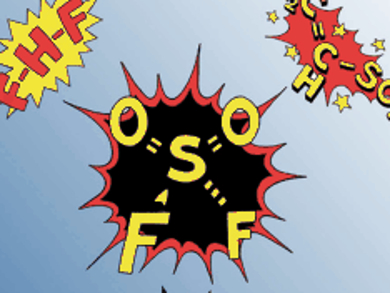Click Chemistry
The coupling of molecular building blocks nearly as easy as “snapping” them together can be realized by means of the “click chemistry” tool kit. American scientists have now introduced another achievement for the click concept in the journal Angewandte Chemie: the sulfur fluoride exchange reaction (SuFEx) can be used to form robust inorganic bridges between carbon centers and opens up a fully unexplored area of chemistry with countless new molecules that could form the basis for new drugs, diagnostics, plastics, “intelligent” materials, and many other products.
Developed in the 1990s by Nobel Laureate K. Barry Sharpless and his colleagues, the concept of click chemistry is aimed at synthesizing target molecules rapidly and precisely from smaller units. The reactions must be specific, broadly applicable, and environmentally friendly while delivering high yields. They must also be based on inexpensive, widely available reagents that react under mild and uncomplicated conditions. Since the discovery of the azide–alkyne cycloaddition reaction in 2002 by the Sharpless team, the click concept has become established as a universal chemical technique.
Sulfur Fluoride Exchange – a Powerful New Reaction
A team led by Sharpless at The Scripps Research Institute in La Jolla (CA, USA) has now developed another groundbreaking click reaction: sulfur fluoride exchange (SuFEx). This reaction exploits the very special reactivity of sulfur fluorides and makes it possible for chemists to bind together molecules of their choice. Like most click reactions, the process itself is an old one that has been improved to allow the previously underestimated sulfate bond to be used as a universally applicable connector for linking a variety of molecular building blocks.
The starting material is a common, commercially available chemical called sulfuryl fluoride (SO2F2) that is widely used as a fumigant against termites and other pests. It was previously considered generally inert – incorrectly, as Sharpless and his co-workers have found. The team was able to make this chemical reactive in a reliable and predictable way. In the SuFEx reaction, the fluoride ion must be extracted from a bond with a hexavalent sulfur atom. This is not so easy, so the SO2–F unit is remarkably stable in typical acidic or basic environments. This bond thus fulfills a central requirement of click chemistry: it remains “invisible” under most conditions, coming to life only on demand.
Wide Range of Possible Applications
A broad palette of potential applications could benefit from this reaction. The teams of Sharpless and V. V. Fokin developed an efficient, nearly quantitative synthesis of high-molecular-weight polysulfate polymers that should be easy to implement on an industrial scale. Linked by sulfate groups, these polymers are sulfur-containing analogues of polycarbonates and represent a new class of plastics potentially superior to present-day materials. One particular advantage is that unlike polycarbonates, which can react with water to give off bisphenol A – a substance that has hormonelike properties and poses problems for both health and the environment – polysulfates are resistant to hydrolysis and thus cannot release monomers.
This is just one application for the SuFEx reactions; many other reactions with other building blocks are possible. An advantage for the biological sciences is that sulfate links do not occur in any life forms and the new SuFEx reaction does not interfere with biological processes.
- Sulfur(VI) Fluoride Exchange (SuFEx): Another Good Reaction for Click Chemistry,
Jiajia Dong, Larissa Krasnova, M. G. Finn, K. Barry Sharpless,
Angew. Chem. Int. Ed. 2014.
DOI: 10.1002/anie.201309399




